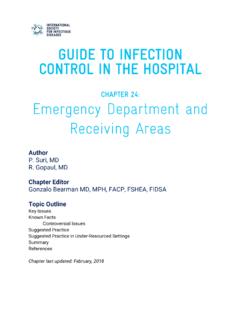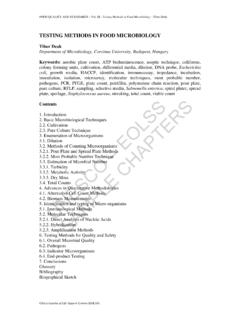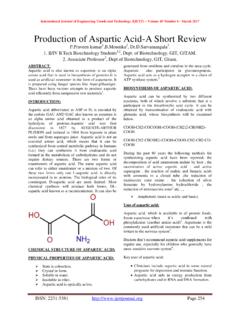Transcription of GUIDE TO INFECTION CONTROL IN THE HOSPITAL - isid.org
1 GUIDE TO INFECTION . CONTROL IN THE HOSPITAL . chapter 22: The Operating Room Author M-C Roy, MD, MSc chapter Editor Michael Stevens, MD, MPH, FACP, FIDSA, FSHEA. Topic Outline Key Issues Known Facts Controversial Issues Suggested Practice Environmental Issues Preparation of the Surgical Team and of the Surgical Field Surgical attire Patient Issues in the Operating Room Suggested Practice in Under-Resourced Settings Summary References chapter last updated: February, 2018. KEY ISSUES. Two to five percent of patients undergoing surgical procedures suffer from surgical site infections (SSIs).
2 These infections cause significant patient morbidity and mortality and burden healthcare systems with immense costs. SSIs are the second most common cause of healthcare-associated infections but the most frequent in low-and middle-income countries (LMICs). In high-income countries (HICs), SSIs are the second most common type of adverse event among hospitalized patients, only surpassed by medication errors, and are the most frequent cause of readmissions. Because SSIs are primarily acquired during the surgical procedure while the wound is open, a number of INFECTION CONTROL practices merit scrutiny in the operating room (OR).
3 With the advent of minimally invasive surgery, the importance of INFECTION CONTROL measures in the OR is much debated. The measures presented in this chapter address environmental and surgical issues as well as some patient-related factors which are implemented once the patient is in the OR. KNOWN FACTS. Many factors contribute to the risk of SSIs and their prevention is complex and requires implementing measures before, during, and after surgery. Most SSIs arise from the patient's endogenous flora, which contaminates the wound by direct contact during the procedure. Therefore, preparing patients for surgery aims at decreasing the microbiologic burden of the patient's bowels, skin, respiratory tract, genital tract, etc.
4 , depending on the procedure being performed. Examples of measures which decrease the microbiologic burden include: showering the patient with an antiseptic (such as chlorhexidine). or plain soap before surgery, giving proper antimicrobial prophylaxis immediately before skin incision and, in some instances, applying 1. mupirocin to the nares for Staphylococcus aureus nasal carriers. The extent of endogenous bacterial contamination at surgery depends on the type of procedure being performed: clean, clean-contaminated, contaminated, or dirty. The risk of SSI increases from <2% for the former to as high as 40% for the latter.
5 The traditional wound classification is only a moderate predictor of the risk of SSI because other factors, host and surgical factors, also influence this risk. Exogenous contamination of wounds is also important in the pathophysiology of SSIs, particularly for clean surgical procedures. The major exogenous source is transmission by air; airborne particles contaminated with live bacteria can enter sterile surgical fields during operation, particularly when implants are being placed ( , total hip prostheses). Airborne bacteria in the OR originate primarily from the skin and hair of individuals in the room.
6 Caps, gowns, and masks are designed to prevent such shedding. The number of persons present in the OR as well as their level of activity, the type of surgery, the quality of air provided, the rate of air exchange, the quality of staff clothing, the quality of cleaning process and the level of compliance with INFECTION CONTROL practices, all influence airborne contamination. Although these may seem trivial issues for contaminated or dirty procedures, they are important to consider in clean and clean-contaminated surgery. Controversial Issues Our understanding of the pathogenesis and prevention of SSI has evolved over recent years but much remains to be done.
7 Many efforts have been made to reduce the airborne bacteria in the OR. ORs equipped with laminar airflow system provide almost sterile air, yet very few studies show a significant decrease in SSI rates for surgical procedures performed in this type of OR. Although revolutionary when first published in 1982, the study on laminar airflow system done by 2. Lidwell and colleagues, as well as more recent studies, all suffer from major drawbacks. Some of these experiments did not CONTROL for the antimicrobial regimen received as surgical prophylaxis, thus precluding any conclusion on the exact role of the laminar flow system.
8 These are complex technologies that must function in strict adherence to maintenance protocols and are more expensive than the use of conventional ventilation systems. Other methods to decrease airborne bacteria in the OR during prosthesis implantation include the use of surgical gowning with exhaust hoods, ultraviolet light, and more recently a device used specifically at the incision site, creating a positive pressure, non turbulent clean air envelope that shields open surgical wounds from airborne bacteria (air barrier system). All these new methods still need more robust study designs to achieve clear conclusions on their benefit during joint replacement surgeries.
9 The association between wearing nail polish by surgical team members and the risk of SSI has not been studied adequately. Therefore, expert societies differ in their recommendations. Some investigators have demonstrated a direct correlation between the duration of open exposure of instrument trays and the risk of bacterial contamination. Therefore, the timing of opening trays should occur as close to the start of the procedure as possible, with a theoretical advantage of covering trays with a sterile drape when not in use but further study regarding timing and techniques of covering trays are needed.
10 Some surgeons adopt a clean closure protocol which includes changing instruments, gloves and gowns before skin closure although no study has demonstrated a benefit of this measure on SSI rates. No well-controlled studies evaluate whether restricting the use of surgical scrubs to the OR suite or allowing them outside the OR will make a difference on SSI rates. Some hospitals require covering gowns when surgeons/nurses leave the OR still wearing surgical scrubs. It 3. would make sense to change grossly soiled scrubs, scrubs worn while changing dressings on wards between surgical procedures, and probably changing scrubs after wearing them for 8 hours or more.






